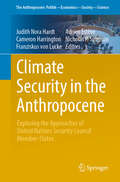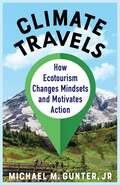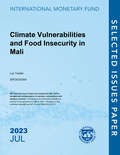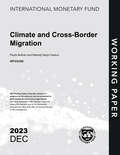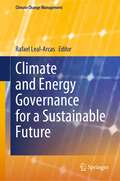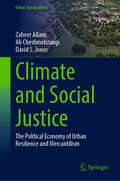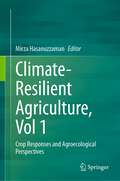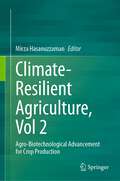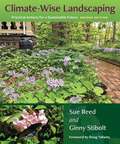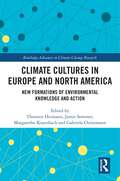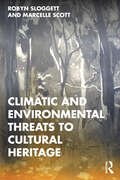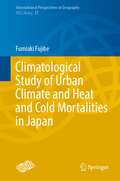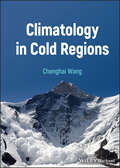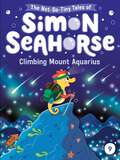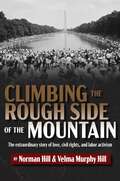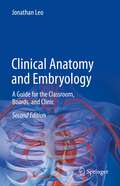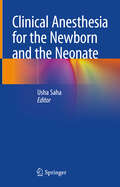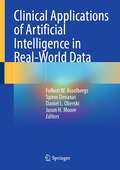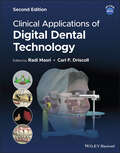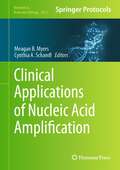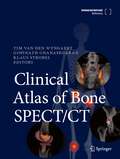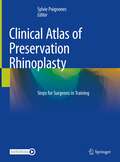- Table View
- List View
Climate Security in South Asia: Proceedings Of A Workshop
by Division on Engineering and Physical Sciences Division of Behavioral and Social Sciences and Education Board on Environmental Change and Society Division on Earth and Life Studies Board on Atmospheric Sciences and Climate National Academies of Sciences, Engineering, and Medicine Intelligence Community Studies Board Climate Security RoundtableThe South Asia region presents a confluence of major climate impacts and key security issues. From a weather and climate standpoint, the region experiences a wide range of hazards, such as the recent heatwaves, droughts, storms, and floods that have upended the lives and livelihoods of millions of people. From a demographic and socioeconomic standpoint, the region is experiencing rapid transformations and progress, even as fundamental challenges such as poverty and inequality persist. From a security standpoint, the region is the setting for a range of social and political dynamics that impact U.S. interests, including conflict at national and subnational levels; regional rivalries; and the imprint of global geopolitics. On October 26-27, 2022, the National Academies of Sciences, Engineering, and Medicine, under the auspices of the National Academies Climate Security Roundtable, convened a workshop to explore climate security in South Asia. Over two days, workshop participants considered some of the underlying climate, development, and geopolitical dynamics at play in the South Asia region; explored a set of historical case studies and future scenarios for climate change and security in South Asia; and they considered the available tools for analysis and forecasting climate-related risks. This publication summarizes the presentations and discussion of the workshop.
Climate Security in the Anthropocene: Exploring the Approaches of United Nations Security Council Member-States (The Anthropocene: Politik—Economics—Society—Science #33)
by Judith Nora Hardt Cameron Harrington Franziskus Von Lucke Adrien Estève Nicholas P. SimpsonThe speed and scale of climate change presents unique and potentially monumental security implications for individuals, future generations, international institutions and states. Long-dominant security paradigms and policies may no longer be appropriate for dealing with these new security risks of the Anthropocene. In response to this phenomenon, this book investigates how states have reacted to these new challenges and how their different understandings of the climate-security nexus might shape global actions on climate change. It focuses on the perceptions, framings, and policies of climate security by members of the United Nations Security Council (UNSC), the world's highest ranking multilateral security forum. Empirically, the book presents detailed, bottom-up case studies from local authors of every UNSC member state in 2020. It combines this with an innovative theoretical approach spanning national, human and ecological security that helps to capture the complex dynamics of state-led approaches to dealing with security in the Anthropocene. This book therefore offers readers a compelling picture of climate-security politics in the UNSC, beyond Council debates and resolutions. By comparing and contrasting how different framings of climate security impact various policy sectors of members states, the authors are able to assess the barriers and opportunities for addressing climate security locally and globally.“This timely contribution to the literature on climate security examines the under-analysed relationship between the policy approaches of key countries at the national, and at the international level. Policy alignment at multiple levels of governance will be critical if we are to respond adequately to the ubiquitous challenges posed by climate change and variability.” Shirley Scott, Head of School and Professor, School of Humanities and Social Sciences, UNSW Canberra at the Australian Defence Force Academy (Australia).
Climate Travels: How Ecotourism Changes Mindsets and Motivates Action
by Michael M. Gunter Jr.Many accounts of climate change depict disasters striking faraway places: melting ice caps, fearsome hurricanes, all-consuming fires. How can seeing the consequences of human impacts up close help us grasp how global warming affects us and our neighbors? This book is a travelogue that spotlights what a changing climate looks like on the local level—for wherever local happens to be.Michael M. Gunter, Jr. takes readers around the United States to bear witness to the many faces of the climate crisis. He argues that conscientious travel broadens understanding of climate change and makes its dangers concrete and immediate. Vivid vignettes explore the consequences for people and communities: sea level rise in Virginia, floods sweeping inland in Tennessee, Maine lobsters migrating away from American territorial waters, and imperiled ecosystems in national parks, from Alaskan permafrost to the Florida Keys. But Gunter finds inspiring initiatives to mitigate and adapt to these threats, including wind turbines in a tiny Texas town, green building construction in Kansas, and walkable urbanism in Portland, Oregon. These projects are already making a difference—and they underscore the importance of local action.Drawing on interviews with government officials, industry leaders, and alternative energy activists, Climate Travels emphasizes direct personal experience and the centrality of environmental justice. Showing how travel can help bring the reality of climate change home, it offers readers a hopeful message about how to take action on the local level themselves.
Climate Vulnerabilities and Food Insecurity in Mali (Selected Issues Papers)
by TuckerA report from the International Monetary Fund.
Climate and Cross-Border Migration (Imf Working Papers)
by Hadzi-VaskovA report from the International Monetary Fund.
Climate and Energy Governance for a Sustainable Future (Climate Change Management)
by Rafael Leal-ArcasThis book includes contributions by leading experts across the globe with the first part of the book focusing on the analysis of the Paris Agreement on Climate Change, examines COP26, and questions the political process in the US for the creation of policy for meaningful greenhouse gas emissions reductions. Part 2 explores various ways in which one can effectively mitigate climate change. The contents provide an analysis of carbon pricing, development of specific green energy technologies to promote economic prosperity, and analysis of electric vehicles and other elements of electrification in areas with carbon-intensive electricity supply. Part 3 analyses the international dimension of energy governance (both regional and global) and climate action. It further provides an analysis of the challenges faced by small island developing states, least-developed countries and other vulnerable places. It also offers an analysis of the prospects for a European Energy Union and explores why energy security and decarbonization are significant. Lastly, it explores global energy governance and how its fragmentation can be reduced. This volume will be a useful reference for those in industry and academia.
Climate and Social Justice: The Political Economy of Urban Resilience and Mercantilism (Urban Sustainability)
by Ali Cheshmehzangi David S. Jones Zaheer AllamThis book offers a fresh perspective on the historical, economic, and cultural foundations of capitalism, cities, and climate change. By exploring the intersection of urbanization, consumerism, and colonialism, the book sheds new light on the origins and development of the economic system that has shaped our world today. What sets this book apart is its unique approach, which challenges conventional wisdom and offers new insights into the complex relationships between culture, politics, and economics. The book is intended for readers interested in the history and evolution of capitalism and its impact on society, as well as those interested in climate change and urbanization. The content level is accessible for general readers, yet sophisticated enough to appeal to scholars and researchers. The two most important features of the book are its fresh perspective on the history of mercantilism and its examination of the economic landscape of cities and climate change. By reading this book, readers gain a deeper understanding of the complex relationships between urbanization, colonialism, and economic policies, and their impact on contemporary society.
Climate, Land-Use Change and Hydrology of the Beas River Basin, Western Himalayas (Advances in Asian Human-Environmental Research)
by Seema RaniThere is a need of strengthening the global and local response to cope with the threat of climate change and adverse effects of rising anthropogenic activities in the mountain ecosystem. This book provides an up-to-date and comprehensive scientific and technical knowledge based on climate and land cover change impact assessment, adaptation and mitigation strategies in the Indian Himalayan watershed. The text updates the understanding scientific analysis to promote evidence-based policy formulation at regional and local levels. It can be used as reference materials with regards to climate and land cover change for those new learners interested in the mountainous region. This comprehensive book covers a wide range of potential research areas including climate change scenarios, science and its applications, adaptation to climate change-theory and assessment, water resources, agriculture, forest, biodiversity, and ecosystems, indigenous knowledge etc.
Climate-Resilient Agriculture, Vol 1: Crop Responses and Agroecological Perspectives
by Mirza HasanuzzamanUnder ongoing climate change, natural and cultivated habitats of major food crops are being continuously disturbed. Such condition accelerates to impose stress effects like abiotic and biotic stressors. Drought, salinity, flood, cold, heat, heavy metals, metalloids, oxidants, irradiation etc. are important abiotic stresses; and diseases and infections caused by plant pathogens viz. fungal agents, bacteria and viruses are major biotic stresses. As a result, these harsh environments affect crop productivity and its biology in multiple complex paradigms. As stresses become the limiting factors for agricultural productivity and exert detrimental role on growth and yield of the crops, scientists and researchers are challenged to maintain global food security for a rising world population.This two-volume work highlights the fast-moving agricultural research on crop improvement through the stress mitigation strategies, with specific focuses on crop biology and their response to climatic instabilities. Together with "Climate Resilient Agriculture, Vol 2: Agro-Biotechnological Advancement for Crop Production", it covers a wide range of topics under environmental challenges, agronomy and agriculture processes, and biotechnological approaches, uniquely suitable for scientists, researchers and students working in the fields of agriculture, plant science, environmental biology and biotechnology.
Climate-Resilient Agriculture, Vol 2: Agro-Biotechnological Advancement for Crop Production
by Mirza HasanuzzamanUnder ongoing climate change, natural and cultivated habitats of major food crops are being continuously disturbed. Such condition accelerates to impose stress effects like abiotic and biotic stressors. Drought, salinity, flood, cold, heat, heavy metals, metalloids, oxidants, irradiation etc. are important abiotic stresses; and diseases and infections caused by plant pathogens viz. fungal agents, bacteria and viruses are major biotic stresses. As a result, these harsh environments affect crop productivity and its biology in multiple complex paradigms. As stresses become the limiting factors for agricultural productivity and exert detrimental role on growth and yield of the crops, scientists and researchers are challenged to maintain global food security for a rising world population.This two-volume work highlights the fast-moving agricultural research on crop improvement through the stress mitigation strategies, with specific focuses on crop biology and their response to climatic instabilities. Together with "Climate Resilient Agriculture, Vol 1: Crop Responses and Agroecological Perspectives", it covers a wide range of topics under environmental challenges, agronomy and agriculture processes, and biotechnological approaches, uniquely suitable for scientists, researchers and students working in the fields of agriculture, plant science, environmental biology and biotechnology.
Climate-Wise Landscaping: Practical Actions for a Sustainable Future, Second Edition
by Sue Reed Ginny StiboltWhat can we do, right now, in our own landscapes, to help solve climate change? Gold Winner, Foreword INDIES Book Awards: Ecology & Environment “Read this book carefully. Everything you need to know to help heal our relationship with planet Earth and empower you to make a much-needed difference is within these pages.”—From the foreword by Doug Tallamy Praise for the first edition: “The volume of information here is impressive, and each action is accompanied by an explanation of why it’s important. . . . Useful whether read cover-to-cover or dipped into for specific topics.”—Booklist“Beautifully designed, the book is user-friendly and attractive. The information is current and science-based, with end-notes that give readers access to further research.”—Virginia Native Plant Society “This fantastic resource is filled with climate-wise solutions for anyone who owns or manages a piece of ground—even if it’s just a few containers on a tiny rooftop garden.”—Claudia West, ASLA, Principal, Phyto Studio LLC “[Reed and Stibolt] articulate a new gardening aesthetic. . . . The result is a positive and hopeful story of how people can use their imagination and ingenuity to help craft more resilient landscapes.”—Dr. Peter Robinson, former CEO, David Suzuki Foundation “Beautiful photos and pleasing graphics illustrate key ideas and actions while informative sidebars and inspiring quotes from climate and landscape experts provide clarity of complex systems and motivation to adapt to a changing future.”—Julie Richburg, Ph.D., ecologist “A book on climate-wise landscaping could not be more timely or more necessary. We are moving into a new and critical era, and this book takes landscape professionals and home gardeners where they need to go.”—Owen Dell, RLA, ASLA, landscape architect, educator, author, Owen Dell & Associates “A very useful guide to designing landscapes for the twenty-first century which clearly respond to our changing climate.”—Darrel Morrison, honorary associate faculty member in landscape architecture, University of Wisconsin-Madison Predictions about future effects of climate change range from mild to dire—but we’re already seeing warmer winters, hotter summers, and more extreme storms. Proposed solutions often seem expensive and complex and can leave us as individuals at a loss, wondering what, if anything, can be done.Sue Reed and Ginny Stibolt offer a rallying cry in response—instead of wringing our hands, let's roll up our sleeves. Based on decades of the authors' experience, this book is packed with simple, practical steps anyone can take to beautify any landscape or garden, while helping protect the planet and the species that call it home. Topics include: Working actively to shrink our carbon footprint through mindful landscaping and gardeningCreating cleaner air and waterMaximizing resource efficiencySupporting birds, butterflies, pollinators, and other wildlife. As climate change continues to intensify around the globe, the information in this second edition of Climate-Wise Landscaping is needed now more than ever. This book is the ideal tool for homeowners, gardeners, and landscape professionals who want to be part of the solution to climate change.
Climate Cultures in Europe and North America: New Formations of Environmental Knowledge and Action (Routledge Advances in Climate Change Research)
by Thorsten HeimannBringing together scholarly research by climate experts working in different locations and social science disciplines, this book offers insights into how climate change is socially and culturally constructed. Whereas existing studies of climate cultural differences are predominantly rooted in a static understanding of culture, cultural globalization theory suggests that new formations emerge dynamically at different social and spatial scales. This volume gathers analyses of climate cultural formations within various spaces and regions in the United States and the European Union. It focuses particularly on the emergence of new social movements and coalitions devoted to fighting climate change on both sides of the Atlantic. Overall, Climate Cultures in Europe and North America provides empirical and theoretical findings that contribute to current debates on globalization, conflict and governance, as well as cultural and social change. This book will be of great interest to students and scholars of climate change, environmental policy and politics, environmental sociology, and cultural studies.
Climatic and Environmental Threats to Cultural Heritage
by Robyn Sloggett Marcelle ScottClimatic and Environmental Threats to Cultural Heritage examines the challenges that environmental change, both sudden and long-term, poses to the preservation of cultural material. Acknowledging the diversity of human cultural heritage across collecting institutions, heritage sites and communities, the book highlights how, in Australia, Southeast Asia and the Pacific, the quest to preserve such precious knowledge relies on records and narratives being available to inform decisions now and into the future. Bringing together a diverse range of stakeholders who have an interest in – and responsibility for – the care of cultural heritage material and places of cultural heritage value, the book explores their thinking on and actions in relation to issues of climate change and environmental risk. Sloggett and Scott highlight the stakeholders’ shared interest in drawing on their expertise to meet the challenges that environmental change brings to the future of our cultural heritage and our cultural identity. Based on the understanding that this global challenge requires local, national and international co‐operation, the book also considers how local knowledge can have international application. Climatic and Environmental Threats to Cultural Heritage will be of interest to those engaged in the study of heritage, conservation, archaeology, archives, anthropology, climate change and the environment. It will also be useful to practitioners and others attempting to understand the effect of environmental change on cultural heritage around the globe.
Climatological Study of Urban Climate and Heat and Cold Mortalities in Japan (International Perspectives in Geography #21)
by Fumiaki FujibeThis book describes observed features of urban climate and its long-term variations as well as the relationship of climate to heat stroke in Japan, based on observational data and statistical analyses. Consisting of three parts, the book is a valuable resource for researchers and professionals involved with these topics. Part 1 focuses on urban climate. The basic characteristics of heat islands are reviewed, and long-term urban warming is described with a focus on the distinction from global warming. The influence of microscale environmental changes on the observed temperature is also presented, as well as changes in wind and precipitation in urban areas. They deepen our understanding of the features and mechanisms of urban heat islands and their long-term changes. Part 2 describes the climatological features of heat stroke mortality, which has become a major social problem in Japan, using mortality statistics and meteorological data. The spatial and temporal variations of heat stroke mortality are analyzed quantitatively on various spatial and temporal scales. In addition, the number of ambulance transports is examined as another measure of heat stroke casualty. The results provide insight into the climatological factors related to heat stroke mortality and contribute to the implementation of preventive measures. The climatology of deaths from extreme cold is also presented. For supplementary information, an overview of the geography, climate, and meteorological data of Japan is presented in Part 3.
Climatology in Cold Regions
by Chenghai WangClimatology in Cold Regions A groundbreaking interdisciplinary study of cold-region weather systems and their vital role in predicting climate change across the globe Climatology in Cold Regions explores the complexities of land−atmospheric interaction across the Earth’s cryosphere, systematically placing soil thawing, snow melting, surface diabatic heating, and other processes within the context of broader climatological models. Drawing from a wealth of new data, leading atmospheric scientist Chenghai Wang illustrates how cold-region weather systems can be parameterized to improve seasonal climate prediction and provide crucial insights into projected changes in climate over the next 50-100 years. The book opens with an introduction to the characteristics and classification of cold-region climatology, followed by a detailed description of the primary weather systems and land surface processes in cold regions. The core of the book presents a new approach for seasonal climate prediction using signals obtained from cryospheric processes, supported by a discussion of climate disasters and the impact of climate change on the ecology of cold regions. Introduces a new way of modeling climate in cold regions Offers novel approaches for assessing climate signals from cold regions in seasonal and sub-seasonal predictions Presents new data on the role of cold-region climatology in forecasting and driving global temperature changes Discusses the role of cold regions as the main source of global freshwater supply A significant contribution to climate research and beyond, Climatology in Cold Regions is essential reading for students, scientists, and researchers in the atmospheric sciences, meteorology, ecology, hydrology, and Earth sciences.
Climbing Mount Aquarius (The Not-So-Tiny Tales of Simon Seahorse #9)
by Cora ReefSimon&’s storytelling takes him all the way to the top of a mountain in this ninth book in The Not-So-Tiny Tales of Simon Seahorse chapter book series.Simon has always loved a good story, but he&’s never heard one quite like Sir Sheldon&’s Mount Aquarius ascent. After his dad tells him the tale, Simon can&’t wait to share it with his friends—with some embellishment, of course. But Simon gets so carried away he ends up announcing his own plans to climb the mountain! Simon immediately regrets the bold claim, but his friends are so excited for him, he can&’t back down. Is Simon really about to face Mount Aquarius? With easy-to-read language and illustrations on almost every page, The Not-so-Tiny Tales of Simon Seahorse chapter books are perfect for emerging readers.
Climbing the Rough Side of the Mountain: The Extraordinary Story of Love, Civil Rights, and Labor Activism
by Norman HillThe remarkable story of a couple who came together during the civil rights movement and made fighting for equality and civil and workers&’ rights their purpose for more than sixty years, overcoming adversity—with the strength of their love and commitment—to bring about meaningful change. &“A chronicle of lives of unwavering dedication. Now in their 80s, labor and civil rights activists Norman and Velma Hill recount more than six decades of struggles, triumphs, and frustrations in their tireless work as &‘crusaders for democracy.&’... An inspiring joint memoir.&” —Kirkus ReviewsWhen Velma Murphy was knocked unconscious by a brick thrown by a man from an angry white mob and was carried away by Norman Hill, it was the beginning of a six-decade-long love story and the turmoil, excitement, and struggle for civil rights and labor movements. In Climbing the Rough Side of the Mountain, the Hills reflect upon their more than half a century of fighting to make America realize the best of itself.Through profound conversations between the two, Velma and Norman Hill share their earliest memories of facing racial segregation in the 1960s, working with Martin Luther King Jr., Bayard Rustin, and A. Philip Randolph, crossing paths with Malcolm X and Stokely Carmichael. They also reveal how they kept white supremacists like David Duke from taking office, organized workers into unions, met with Presidents Bill Clinton and Barack Obama, and continued to work tirelessly, fighting the good fight and successfully challenging power with truth.
Clinical Anatomy and Embryology: A Guide for the Classroom, Boards, and Clinic
by Jonathan LeoThis second edition was updated and will again be of great value to medical and other allied health students. It seeks to aid students in gaining a general understanding of clinical anatomy before embarking on a specific discipline-focused program.The purpose of this text is not an exhaustive deep dive into all of gross anatomy. There are numerous other books that have done this. Likewise, it is not meant to be just a quick overview. Rather, it is meant to present each anatomical topic with clinical scenarios in mind. Hopefully, it will help first-year students with their course, second-year students looking for a refresher before boards, and third- and fourth-year students looking for a refresher before rotations.Organized among two sections, the first includes chapters that cover the anatomy of the head and neck, abdomen, thorax, pelvis and perineum, lower limb, upper limb, and back. What’s more, section two briefly examines the embryology and development of the organ systems, such as the development of major organs.This new edition is again an invaluable resource for students who wish to retain anatomical knowledge on the entire human body despite an eventual career in one particular discipline of medicine. It is complemented by its previously published sister text Medical Neuroanatomy for the Boards and the Clinic, now in second edition, which applies similar principles of anatomical information with a focus on identifying potentially malignant lesions.
Clinical Anesthesia for the Newborn and the Neonate
by Usha SahaThe book covers all aspects of anesthesia in newborns, neonates (under 28 days) and premature babies. These patients are highly vulnerable, very small in size and weight, at very high risk, and have high mortality and morbidity, which gets further aggravated by the medical diseases and congenital abnormalities these babies may suffer from. The book provides knowledge that equips the anesthetists with the regional techniques used to provide both anesthesia and analgesia, including information about the drugs used, skills in providing neuraxial blocks, nerve blocks, etc., complications thereof and the specially designed equipment for these patients (IV cannula, endotracheal tubes, ryles tubes, laryngoscopes, SpO2 probes, monitors, incubators, warmers and heaters, mattresses, OT tables). The book covers the pharmacology of drugs used, the effect of anesthetic drugs on the developing brain, pulmonary physiology, airway assessment and management, ventilation modes, getting IV and arterial access, preoperative workup, anesthetic management, and postoperative care. It includes care and concerns from both surgical and anesthesia aspects. It covers all the common surgical diseases along with some rare cases such as oncological concerns, palliative care, ethical concerns and pain management. The book also discusses the role and use of ultrasound. The chapter on anesthesia for short procedures includes common birth and neonatal care injuries. The book contains chapters on fluid therapy, blood and blood product transfusion guidelines and indications, resuscitation of a newborn and neonate, and neonatal rehabilitation to improve neonatal outcomes. It contains a dedicated chapter on why these babies are at a high risk of morbidity and mortality and contributing maternal factors. All the chapters are written by experts in their fields with vast experience. This book bridges the gap in the knowledge of an anesthesiologist between anesthesia for children and adults and newborns, neonates and preterm babies.
Clinical Applications of Artificial Intelligence in Real-World Data
by Jason H. Moore Folkert W. Asselbergs Spiros Denaxas Daniel L. OberskiThis book is a thorough and comprehensive guide to the use of modern data science within health care. Critical to this is the use of big data and its analytical potential to obtain clinical insight into issues that would otherwise have been missed and is central to the application of artificial intelligence. It therefore has numerous uses from diagnosis to treatment. Clinical Applications of Artificial Intelligence in Real-World Data is a critical resource for anyone interested in the use and application of data science within medicine, whether that be researchers in medical data science or clinicians looking for insight into the use of these techniques.
Clinical Applications of Digital Dental Technology
by Radi Masri Carl F. DriscollClinical Applications of Digital Dental Technology Comprehensive overview of digital dentistry describing available technologies and when/how to use digital dentistry in practice Clinical Applications of Digital Dental Technology provides comprehensive yet practical references to a wide range of potential uses for digital technology in dental practice, discussing a wide range of digital technologies including their indications, contraindications, advantages, disadvantages, limitations, and applications. Overall, the book emphasizes how to use digital dentistry in daily practice across all specialties. With broad coverage of the subject, Clinical Applications of Digital Dental Technology discusses digital imaging, digital impressions, digital prosthodontics, digital implant planning and placement, and digital applications in endodontics, orthodontics, and oral surgery. Each chapter is written by experts in each topic and covers applications for prosthodontics, implant dentistry, oral surgery, endodontics, orthodontics, and other specialty areas. Clinical Applications of Digital Dental Technology also includes information on: Software, scanning, and manufacturing capabilities which have led to an unparalleled revolution leading to a major paradigm shift in all aspects of dentistry Digital radiography, virtual planning, computer-aided design and manufacturing, digital impressions, digitally fabricated dentures, and the “virtual patient” Available technologies, plus a critical evaluation of each one to detail how they are incorporated in daily practice across all specialties Developing technologies in the field with special attention paid to those expected to be on the market sometime in the near future Clinical Applications of Digital Dental Technology is an essential resource for general dentists, specialists, and students who wish to understand digital dentistry and efficiently and intelligently incorporate it into their practices. The text is also useful for laboratory technicians interested in recent digital advances in the dental field.
Clinical Applications of Linguistics to Speech-Language Pathology: A Guide for Clinicians
by Naomi Gurevich Christopher M. GrindrodClinical Applications of Linguistics to Speech-Language Pathology is a practical guide that provides linguistically grounded approaches to clinical practice. It introduces key linguistic disciplines and discusses how they form a basis for assessment and treatment of individuals with communication differences or disorders. Written by experts in linguistics and communication disorders, each chapter provides clinicians with a foundational understanding of linguistics as it applies to spoken and signed languages and underscores the importance of integrating linguistic theories into clinical decision-making. The book is divided into two parts that focus on the applications of linguistics to speech and language differences and disorders in both children and adults. The chapters cover the full range of linguistic domains including phonetics, phonology, morphology, syntax, semantics, pragmatics, and sociolinguistics. Applications to a wide range of populations including childhood apraxia of speech, aphasia, dysarthria, traumatic brain injury and accent modification clients are also discussed. Many chapters include assessment and treatment resources that can be used by practicing clinicians. This highly accessible and comprehensive book is an indispensable resource for practicing speech-language pathologists and other members of the profession, including instructors with minimal exposure to linguistics. It will also be beneficial for students of Linguistics, Speech and Hearing Sciences, and Audiology and Speech Language Pathology who are seeking practical knowledge of the fields.
Clinical Applications of Nucleic Acid Amplification (Methods in Molecular Biology #2621)
by Cynthia A. Schandl Meagan B. MyersThis volume details applications, methods, and protocols on nucleic acid amplification. Chapters detail the management of organ and stem cell transplantation, constitutional genetics and genomics, epidemiology, public health, nucleic acid detection, methods for amplification and sequencing, nuclease-assisted mutant allele enrichment, isothermal, and high-throughput sequencing. Written in the highly successful Methods in Molecular Biology series format, chapters include introductions to their respective topics, lists of the necessary materials and reagents, step-by-step, readily reproducible laboratory protocols, and tips on troubleshooting and avoiding known pitfalls. Cutting-edge and thorough, Clinical Applications of Nucleic Acid Amplification is a valuable resource for both novice and expert scientists in this developing field.
Clinical Atlas of Bone SPECT/CT
by Gopinath Gnanasegaran Tim Van den Wyngaert Klaus StrobelThis clinical atlas is a comprehensive reference work on bone and joint disorders that can be characterized and assessed with hybrid bone SPECT/CT. It is structured according to the major joints and regions of the skeletal system, including spine, shoulder and elbow, hand and wrist, pelvis and hip, knee, and foot and ankle. For each region, the annotated normal X-ray and cross-sectional anatomy is presented, followed by a general introduction to the most common pathologies and frequent surgical procedures. Optimal bone SPECT/CT acquisition parameters are summarized and pre- and postoperative conditions are then discussed with the aid of informative clinical case vignettes featuring not only bone SPECT/CT images but also correlative findings on other imaging modalities. For every case, teaching points highlighting need-to-know findings and common pitfalls are presented. The book concludes with two dedicated chapters covering bone SPECT/CT imaging in sports injuries and oncology. Featuring many high-quality illustrations, Clinical Atlas of Bone SPECT/CT will be an invaluable resource for all nuclear medicine physicians. It is published as part of the SpringerReference program, which delivers access to living editions constantly updated through a dynamic peer-review publishing process.
Clinical Atlas of Preservation Rhinoplasty: Steps for Surgeons in Training
by Sylvie PoignonecRhinoplasty is one of the most challenging procedures in facial plastic surgery, as treatment has to be carefully tailored for each patient; nowadays the concept of preservation rhinoplasty is particularly sought-after, allowing to conserve cartilage bone structure, and avoiding secondary surgery with costal grafts. Thought for the young surgeon in training, this richly illustrated clinical cases atlas in rhinoplasty offers all needed tools to correctly classify the malformation and choose the best reproducible treatment. Chapters clearly illustrate the principal approach with closed technique, to which specific parts on transcolumellar approaches are added, beginning with the simpler cases and progressing stepwise to more complex cases. Each part is supported by the addition of high quality illustrations and surgical videos to foster the reader’s understanding and preparation of practical steps and best choices, offering direct support in the operating room. The chapters move from the clinical examination, to photography, topography and deformation measurement (TDM) in 3D, computer simulations and the building of a dedicated preoperative check list to endure a careful patient approach and secure the best outcomes for the most frequent rhinoplasty cases. Plastic surgeons in training and ENT doctors alike will find this Clinical Atlas of Primary Rhinoplasty to be a handy guide to resort to, when wanting to improve their daily practice.Via app: download the SN More Media app for free, scan a link with play button and videos directly on your smartphone or tablet.

